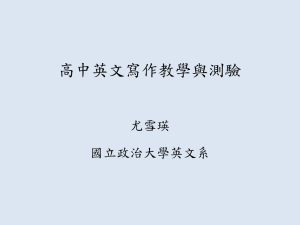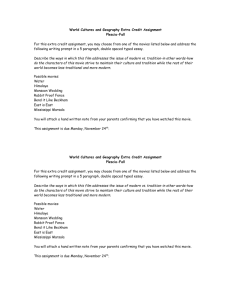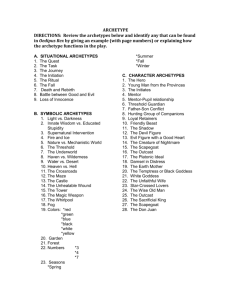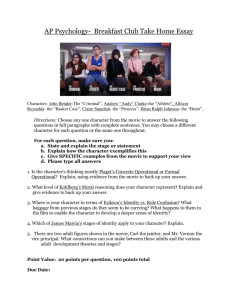Using Movies as a Meof Literary Analysis
advertisement
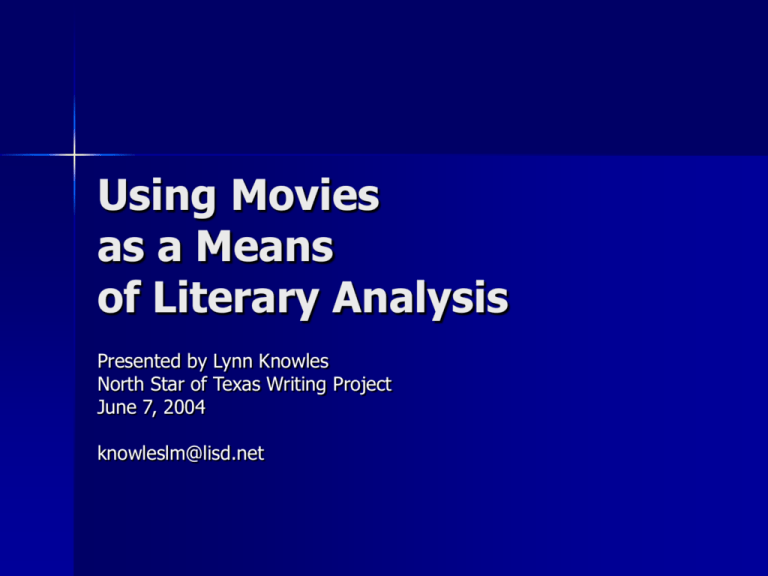
Using Movies as a Means of Literary Analysis Presented by Lynn Knowles North Star of Texas Writing Project June 7, 2004 knowleslm@lisd.net Quick Write What is your favorite movie? Brainstorm & Discuss Why do we watch movies? What are the genres of movies? How do movies compare to books or other entertainment? Writing Exercise Convince me to see your favorite movie. Preparation: Discuss teacher as movie viewer – different from student as movie viewer. Discussion of audience and tone. Best Sentences Aladdin – While the “magical” aspect of the movie dazzles the children, the deeper concepts hold the adults. Field of Dreams – It is not the magical aspect of the movie that gives us hope, it is the joy of watching people learn to appreciate the simple, often overlooked parts of life. Forrest Gump – Viewers become engulfed in the drama of the movie from the moment it begins to play, and as Forrest tells his story, they feel that they are a part of it, too. Italian Job – It is not the individuals that make their goal possible, but their teamwork and trust that lets them accomplish their task and succeed in getting their gold. Life of David Gale – This becomes a film not about Gale’s current situation, but about the consequences of Gale’s actions and the ultimate purpose of his crime. Lion King – Running away from your problems will only cause them to become greater, and Hakuna Mattata can only help you for so long. Master and Commander – The movie knows what it has to do and does not try to be more than that, a downfall of many other large-scale productions. A Night at the Roxbury – A Night at the Roxbury is filled with fun and adventure that will make you laugh until you wet yourself, cry until you wish you had never watched the stupid movie, and feel suspense that would have even Edgar Allen Poe shaking in his boots. Web Sites of Movie Reviews www.mrge.com www.imbde.com www.movie-reviews.colossus.net www.filmcritic.com www.All-Reviews.com www.CriticsNest.com Movies serve the function of all storytelling, to entertain, inspire and perhaps even teach us to cope with problems. Delving into the inner workings of great cinema making means becoming immersed in the elements of a good story. - Stuart Voytilla Moviemaking can be considered the contemporary form of mythmaking. Many of our most memorable movies follow the classic configuration of the Hero’s Journey. - Stuart Voytilla Archetypes An archetype is a pattern or model that serves as the basis for different – but related – versions of a character, plot, image, or theme. Heroic Pattern Call Response Departure Conflict Transformation Return Hero Archetypes The Hero The Young Man from the Provinces The Initiate Relationship Archetypes Mentor-Pupil Relationship Father-Son Conflict The Star-Crossed Lovers Character Archetypes Mentor Threshold Guardian Hunting Group of Companions Evil Figure with the Ultimately Good Heart Scapegoat Outcast Female Archetypes Earth Mother Temptress Platonic Ideal Amazon Warrior Unfaithful Wife Damsel in Distress Place Archetypes Threshold Underworld Wilderness Garden Crossroads Situation Archetypes Quest Task Initiation Journey Fall Death and Rebirth Student Responses A Beautiful Mind Call = to break codes for military agency Journey = into unreal world Transformation = comes through therapy and medication Fall = descent into schizophrenia Finding Nemo Mentor-Pupil = Dory to Marlin Innate Wisdom = Dory Father-Son Conflict Miss Congeniality Call = to become undercover agent Damsels in Distress = beauty contestants Mentor = Michael Caine’s character Office Space Initiate = Peter Hunting Group of Companions = best friends Outcast = Milton Devil Figures = bosses Damsel in Distress = Jennifer Aniston’s character Remember the Titans Mentor = Coach Boone Threshold Guardians = picketers outside the school Journey = early morning run to Civil War battlefield Wilderness = old school house out of town and near the woods The Ring Heroic Pattern Call = death of niece Response = investigation Stony Place of Suffering = well made of stone Stairs = Katie runs up them, symbolizing a dangerous way into the unknown You’ve Got Mail Maternal Figure = Birdy Evil Figure with the Ultimately Good Heart = Joe Fox TEKS connections (from English II) The student is expected to write in a variety of forms with an emphasis on persuasive forms. write in a voice and a style appropriate to audience and purpose. organize ideas in writing to ensure coherence, logical progression, and support for ideas The student is expected to compile information from primary and secondary sources in systematic ways using available technology. The student is expected to draw upon his/her own background to provide connection with texts. The student is expected to compare reviews of literature, film, and performance with his/her own responses. The student is expected to compare and contrast varying aspects of texts such as themes, conflicts, and allusions. understand literary forms and terms… The student is expected to evaluate the credibility of information sources, including how the writer’s motivation may affect that credibility. The student is expected to identify and analyze the effect of artistic elements within literary texts. evaluate artistic performances. The student is expected to deconstruct media to get the main idea of the message’s content. recognize how visual and sound techniques or design convey messages in media. Final Comments Work Cited Voytilla, Stuart (1999). Myth and the movies: discovering the mythic structure of 50 unforgettable films. Studio City, CA: Michael Wiese Productions.

